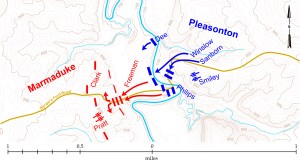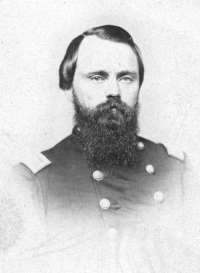Search:
Powered by
Website Baker
Tour Stop, “Byram’s Ford Road, East”
[Waypoint = 39.017896, -94.521194]
Directions
From the Dee’s Battalion River Crossing position, walk back up the trail to return to Hardesty Avenue. What great exercise! Walk south along Hardesty Avenue until you reach the Byram’s Ford Road back near where you parked initially. At this point, the Byram’s Ford Road was heading in a southwesterly direction. Walk down the Historic Byram’s Ford Road towards the Big Blue River until reach the point where the road bed drops down into the flood plain of the Big Blue River, about 100 yards from Hardesty Avenue. Look for another one of those temporary signs attached to a thin, orange fiberglass pole, about three feet tall.
Description
|
Map of Federal attack and crossing at Byram's Ford on October 23, 1864 by theCivilWarMuse based on USGS 1935 Kansas City Quadrangle (Click map for larger image) |
As you walk down the Historic Byram’s Ford Road, you are following the same route taken by the men in the brigade commanded by Colonel Philips, Colonel Winslow and Brigadier General Sanborn. We learned at a previous tour stop (Federal Attack, October 23) the initial attack by Philips’ Brigade did not succeed in getting across the Big Blue River.
Colonel Edward F. Winslow reacted to this setback by sending Dee’s Battalion over to the right and ordering the remainder of his brigade down the hill to the right of Philips’ Brigade. Following in support was Sanborn’s Brigade. Colonel Philips ordered his men to dismount and renew their attack. Meanwhile, the Confederate skirmishers did not discover the movements of Dee’s Battalion until they crossed to the west side of the river. Dee’s attack on the Confederate left flank caused enough confusion to allow Philips and Winslow to get across to the west bank of the Big Blue River. The Confederate skirmishers from Freeman’s Brigade were forced to fall back across the open meadow to the Confederate defense line on Bloody Hill.
Historical Vignettes
|
Colonel John F. Philips, WICR 31832 in the collection of Wilson’s Creek National Battlefield. Image courtesy of the National Park Service |
Colonel John F. Philips, Seventh MSM Cavalry, described the attack in his official report.
The enemy had planted a heavy gun as to sweep this ford, and shelled us furiously, killing a number of horses and men in the stream. Nothing daunted the cavalry resolutely forced its way through. Lieutenant-Colonel Crittenden had, in the meantime, effected a crossing, bore to the right, engaging the enemy fiercely. Kelly's cavalry gained the western bank and formed in Crittenden's rear, when the latter swung quickly to the left of the road, pressing hard upon the enemy in his front, Major Kelly making a similar move on the right. The enemy was driven back about 200 yards, where he occupied a range of hills, extending through an open field on our left and along a craggy bluff, covered with dense woods, on our right.
Captain Richard J. Hinton, commanding the Second Kansas Colored State Militia in the Army of the Border, described the Federal attack that finally succeeded in getting across the Big Blue River.
The enemy were posted in strong force on the west side of the stream; the ford and approaches being obstructed by Colonel [Charles] Jennison's defenses, materially strengthened by the rebels when they occupied his position. Their line was formed in force about a half mile from the stream. Bearing upon the ford, a heavy gun was planted, by which our line, as it formed and advanced was seriously annoyed, and quite a number killed and wounded.
One battalion of the 4th Iowa Cavalry, under command of Captain [Edward W.] Dee, one hundred men of the 4th Missouri Cavalry, and the 7th M. S. M., commanded by Lieutenant-Colonel [Thomas T.] Crittenden, were dismounted and formed on the banks of the river. The firing opened sharp and effective. The 4th M. S. M., Major [George W.] Kelly commanding, and the 1st M. S. M. Cavalry, commanded by Lieutenant-Colonel [Bazel F.] Lazear, were formed in column, directed to cross and charge the enemy beyond the ford. This order was executed in the face of the galling rebel fire and despite the obstacles in the creek. A number of men and horses were killed and wounded in the stream. Nothing daunted, our troops resolutely pushed forward and gained the west bank.

